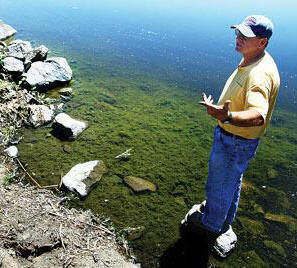|
Working against
forces of nature
By Laura McVicker, Herald and News
7/23/06
H&N photo by Todd E. Swenson Steve
Kandra, 53, owns farmland that is
irrigated and protected by the Westside
Improvement District's dikes. He also
has a contract to maintain five miles of
dikes for the district. The district
services three farms and 1,200 acres and
is part of the flood protection plan for
the town of Tulelake.
TULELAKE
— Steve Kandra says he worries every day
of his life about the ability of five
miles of dike to withstand flooding
along Tule Lake. |
 |
“When the wind blows and the water levels
are high, you lose sleep,” he says.
Kandra is among farmers in the Westside
Improvement District who own the Tule Lake
dike. The Westside Improvement District is in
charge of the maintenance of the dike, but,
under an agreement, Kandra is the contractor
of all five miles.
He is one of an undetermined number of private
dike owners in Klamath and Siskiyou counties
who are responsible for maintaining their
dikes.
Kandra owns 500 acres of farmland adjacent to
the dike where he grows alfalfa, wheat and
potatoes. Other farmers grow mint and other
agricultural products.
Tough winters
Sometimes he feels he’s working against forces
of nature that threaten to erode the dike —
winter months are especially grueling, he
says.
Ice pushes the dike, which Kandra describes as
“floating” on lake floor material or “muck.”
Wind also pushes it, Kandra adds, and he’s
seen the dike move in recent years.
Muskrats and other rodents are nuisances to
his dike because they burrow in it, and he
continually must haul dirt and rock to
reinforce the sides.
In addition, Kandra deals with an Endangered
Species Act mandating water levels be at a
specific height in Tule Lake to protect
wildlife. He cannot build the dike at a height
that would cause water levels to decrease, he
says. But high water levels cause him to worry
about flooding.
“I’m in a Catch 22,” he says.
The family ownership of the dike goes back to
World War II, Kandra says, when his
grandfather acquired it. The lineage of
ownership went to his parents, and Kandra
bought it from his mother in 1989.
Kandra never sees cracks, but constantly
battles erosion — especially after this past
winter because of the intensity of storms.
He says he fears a dike failure because
farming is his primary source of income, and
he also could lose millions of dollars of
farming equipment. He doesn’t build on the
land for fear of flooding.
“You can’t be passive about levees or dikes,
you’ve got to keep on them all the time,” he
says.

